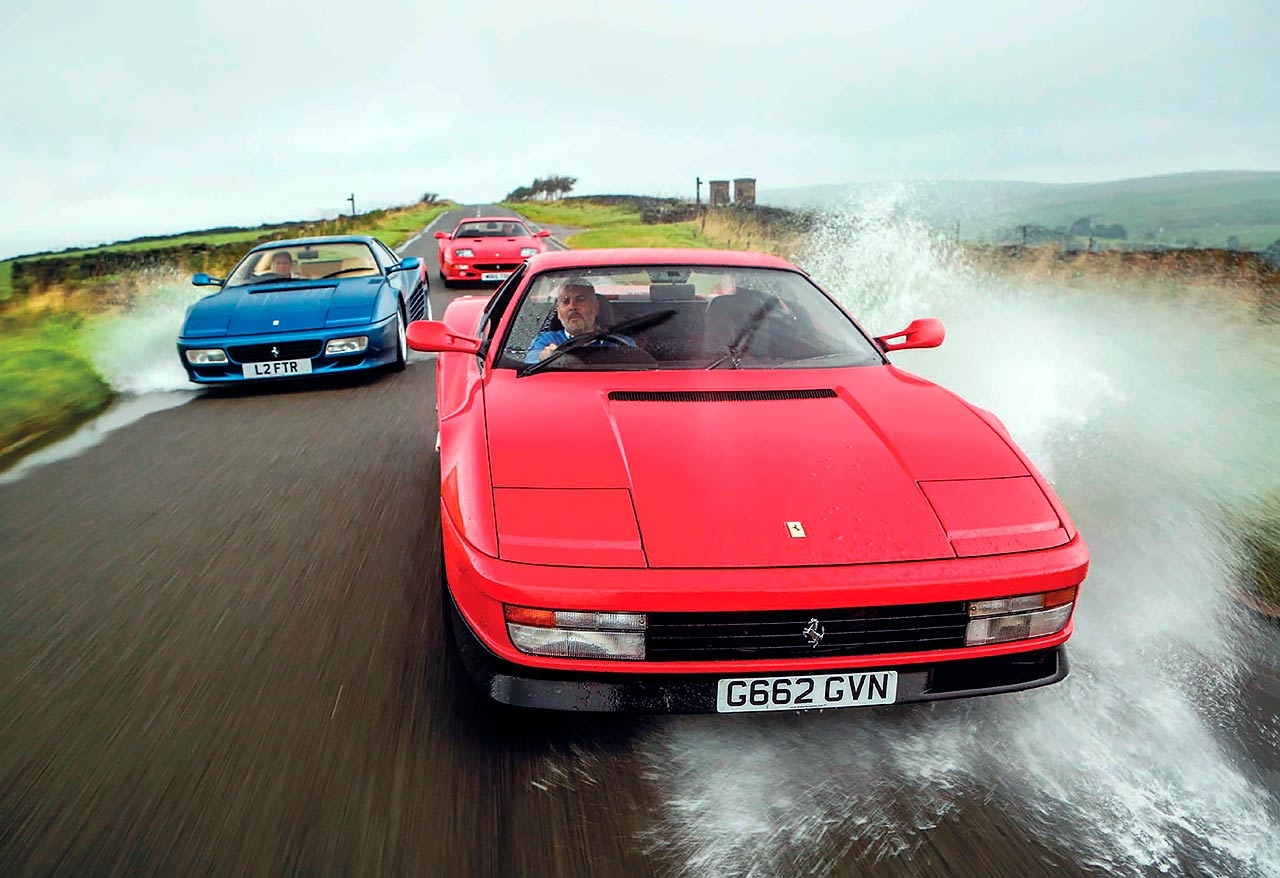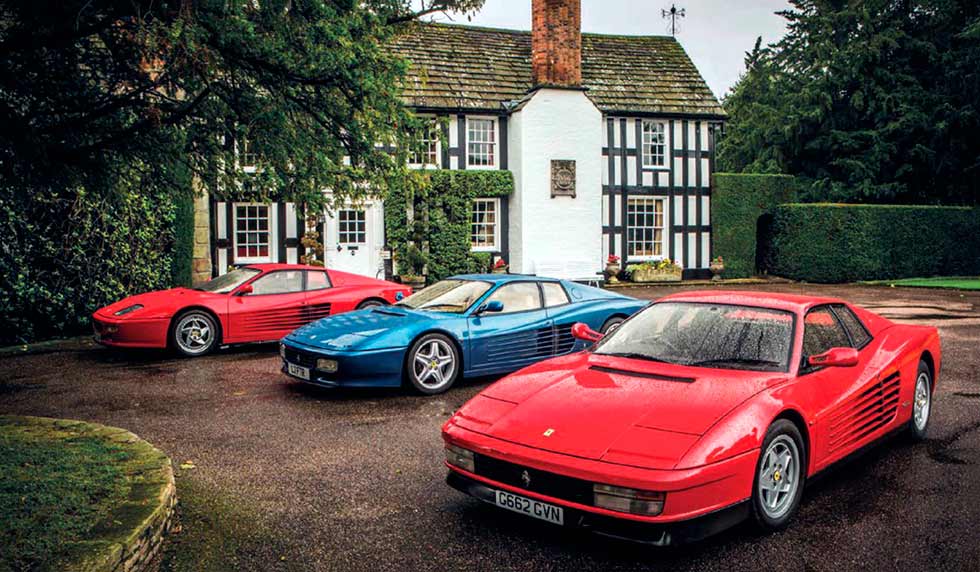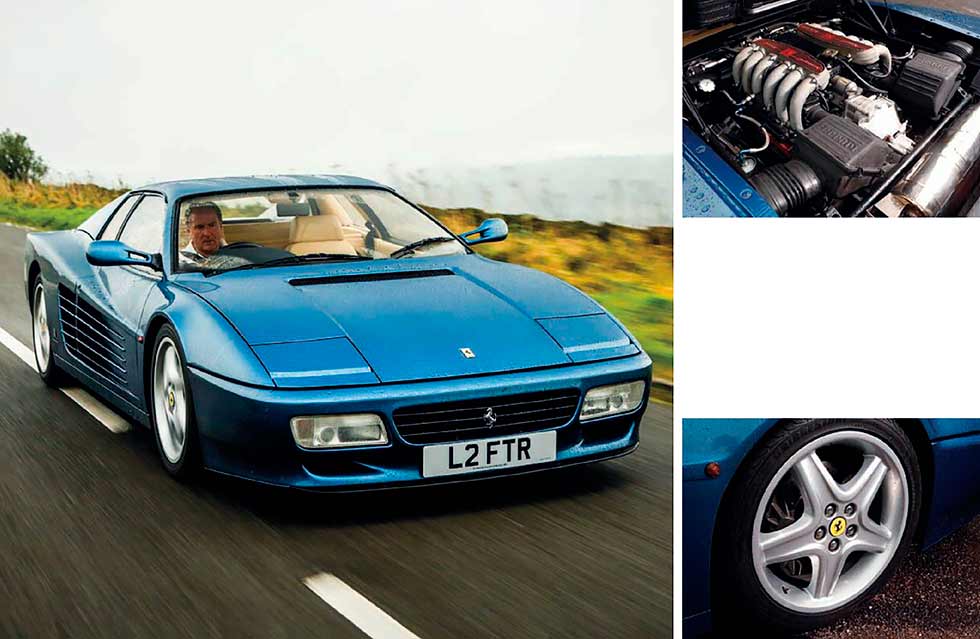
Glorious Redheads. Testarossa generations. Forget your preconceptions about the Testarossa, 512TR and F512M, these flat-12 monsters are sublime. Don’t listen to pub bores, says Mark Wheeler after sampling Testarossa, 512TR and F512M: Ferrari’s flat-12 pin-up is a fantastic drive. Photography Tony Baker.
A bright red Ferrari Testrossa sits alone in the middle of a courtyard. I stop dead in my tracks and stare, transfixed by its aesthetic drama, its proportions, its sheer extravagance. This is largely unnecessary. After all, I’m about to spend an entire day with these beasts, but alas, I have no control over such a spontaneous reaction. More than 30 years on, the flat-12 Ferrari still has the power to leave us mesmerised and entranced – just like a real supercar should.

The Testarossa and its developments, the 512TR and F512M, have been doing rather well of late in the classic car boom. You will recall that there was a time, not so long ago, when the original version in particular was astonishingly cheap, and most definitely out of favour. The perception was that they were crass and, moreover, not especially good to drive – hailing from an era when Ferrari had dropped the ball, or so the man in the pub would tell you.
Some of us never lost the faith, because – and I suspect that, if like me you’re currently in your late 30s, you’ll agree with this – the Testarossa will always be cool. It will always be that pixellated drop-top in Outrun, that car on the dark night streets of 1980s Miami. The Testarossa is the ’80s, and the ’80s are cool again.
Project F110AB was the answer to criticism – from within Ferrari as well as from customers – of the ‘Boxer’ series of supercars. Begun in 1978, the new model was intended to provide not only more power and better handling, but to offer increased luggage space, improved heating and ventilation, plus compliance with American emissions and safety legislation. It was to have a name, too, not just a number. Maranello dug out its back catalogue and extracted one of its most famous sobriquets of all – Testarossa, or ‘red head’, after the Rosso Corsa cam covers of the Scuderia’s late-’50s sports-racers.
Much of the Testarossa may have been new, but old hands most certainly guided it. Project manager Dr Ing Angelo Bellei had overseen the 158 that took John Surtees to the Formula 1 world title in 1964. Ing Nicola Materazzi, who was in charge of the new F113A engine, has a CV that will make you rock on your chair: Lancia Stratos, F40, Osella F1, the list goes on and on. Then there was the styling, headed by the legendary Leonardo ‘Mr Daytona’ Fioravanti at Pininfarina, among so many others.
The chosen design, penned by Emmanuele Nicosia, made a real feature of the new car’s key point of difference with the Boxer: the radiators were moved from the nose to the sides. This freed up luggage space, and gave the car its width and unmistakable proportion; Nicosia channelled the air with strakes, and a much-copied styling feature of the decade was born.
Materazzi’s new engine introduced four-valve heads to the big flat-12, the belt-driven cams being run directly from the crank in the F113A. The power unit was up and running by 1981, and fitted into the first prototype in 1982, three years after the initial wind-tunnel models. ITCA of Turin would eventually construct 30 prototypes, three of which survive today. The car went into pre-production in January 1984, ahead of series production in July of the same year.
The new Ferrari was launched to the press at the Lido on the Champs-Elysées on the eve of the 1984 Paris Salon de l’Auto, where it caused a sensation. The crisp, square-cut, almost deliberately functional lines and superior mechanical specification instantly rendered the 512BBi yesterday’s car, something redolent of the previous decade. The Testarossa was fresh and forward-looking – there wasn’t, and still isn’t, a retro-themed line in its entire form.
Ferrari would go on to build an amazing 7177 Testarossas, evidence of the enduring popularity of the model throughout the ’80s. On sale in the UK from ’1984 priced at £62,666 and with the only option a Schedoni fitted luggage set, these early cars are today known as ‘Monospechio’ because of their slightly bizarre single highlevel door mirror. That particular feature lasted until the Geneva Salon in 1986, but the other Testarossa differentiator – single-nut ‘Monodado’ wheels – remained until June ’1988. Initially there were three types of wheel available, with one serving Michelin’s TRX metric tyres, the standard fitment being 16in diameter rims all round – 8in wide at the front end, with massive 10in items on the rear axle.
The final Testarossas are sometimes called ‘88.5’ models, and featured a lot more changes than just the new five-stud wheels. There were modifications to the steering column, suspension, including the dampers, a wider track and new brake discs. Early versions ran the ‘A’-spec engine with Bosch K-Jetronic injection and no cats, but from 1989 there was the ‘B’ motor with KE-Jetronic and catalytic converters.
It’s one of those later-spec models that we have here today, and the first myth to fall is that oft-repeated belief that the Testarossa is a big car, its width across the beam making it tricky in town. As you sit inside the broad cabin the rear haunches are visible in the mirrors, and for the first mile that thought remains near the front of your mind in busy traffic. But then you compare the size of the car to the current Ford Focus that’s alongside, and realise it’s actually rather small by modern standards. Sure, the Ferrari must have dwarfed 1984’s equivalent, the Mk3 Ford Escort, but times have definitely changed.
I’m surprised: the Testarossa is roomy, it’s actually very comfortable, and it’s also strangely quiet. It’s not a hardcore, track-focused sort of mid-engined supercar at all; it’s a demure grand tourer, with a powerhouse of an engine sat right behind your shoulders. Nevertheless, I am circumspect in my driving today, particularly given the disappointingly wet weather.
The steering is acceptably light around the straight ahead but quickly weights up with some lock on, and there’s a barely perceptible sensation of the car rolling across the rear axle. Given the amount of weight behind – and up high – the spectre of terminal roll oversteer nags away and won’t leave me be. I’m sure there’s a good deal of performance to be exploited before matters reach that stage, but I just don’t know how far I can trust the Ferrari in these conditions. Better, then, to revel in the drama of the car, the way the ‘twelve’ swells in delivery and finally finds its voice at high revs, how utterly fantastic the shape looks when you catch sight of it reflected in a shop window. It would surely be so easy to use one of these cars every day and, chatting to marque specialists later, the concensus is that while not many are driven (due to their investment potential) they’re all the better if they are.
After the Testarossa, the 512TR is a completely different driving experience, but if you consider what lies beneath the outwardly similar exterior that should come as no great surprise. Oh sure, there are subtle stylistic updates: the exterior features more colour-coded elements, the taillamps are different and, most obvious to these eyes at least, the buttresses are longer and flow right down to the edge of the rear deck. The more you look, the more different it appears, but it still seems like a facelift and nothing more.
In fact, the TR is a major departure. Launched in early 1992 but begun as a project in ’1987, it could also boast a stellar cast among its senior engineering team – Roberto Corradi, Paolo Martinelli (later Maranello’s F1 engine man for a dozen seasons) and Amedeo Felisa, who would become Ferrari CEO and only retired in 2015. The flat-12 is the heart of the car once again, and was significantly upgraded you won’t be surprised to hear, but it’s the engine’s immediate surroundings that are almost as significant.
Gone is the engine cradle of the Testarossa, replaced by a one-piece chassis structure for much greater torsional stiffness. The motor is positioned 30mm lower, too, the high centre of gravity having been an issue going right back to the 365GT4 BB. The new power unit features Nikasil-coated cylinder liners, a different air intake, larger intake valves and a revised exhaust, and is controlled by a much more modern Bosch Motronic 2.7 engine management system. The result is 421bhp, deployed via a new single-plate clutch, revised gearshift and ‘modern’ lowprofile rubber on 18in rims. The steering has a quicker ratio, there are new dampers and, crucially, larger cross-drilled brake discs. And that’s just a brief summary.
The 512TR is so well sorted after the Testarossa. It has that wonderful knack, possessed by the best performance cars of the ’90s, of being almost current in performance terms, but with the fullness of feedback so cherished in classics. It immediately feels more agile, taut, alert and responsive. Frankly, it’s really easy to drive, the gearshift tight and utterly precise, the steering and the way the car responds to it far more progressive and trustworthy. Despite its size and reputation, I am at home in the 512TR from about the 100th yard. The flat-12 picks up much more cleanly and enthusiastically, with more voice at lower revs – and then gets truly ferocious towards the redline. Again, the weather is definitely not helping, but I decide there and then that I must one day have a 512TR.
Have we saved the best for last? Some Ferrari enthusiasts will say not. The F512 Modificato’s rather odd, curved spoke wheels and the conversion from flat snout ‘pop-up’ headlamps to fixed units in a more rounded nose have not traditionally found favour from an aesthetic point of view.
But the car has a not-so-secret weapon and, as I am about to learn today, it’s enough to leave you gasping for breath. The F113G040 flat-12 engine that powers the last of our triumvirate is an absolute force of nature – particularly so when allied to the sports exhaust system fitted to this magnificent left-hand-drive example that was recently imported from Japan.
The outputs now stand at a hefty 440bhp and 370lb ft, but it’s the titanium conrods, lighter crankshaft (by 7.26kg), higher compression ratio and the ability to spin round to 7500rpm that really make this engine special. It growls, it purrs, it wails, and has a personality so big, you never feel as though you’re the equal of it. Mated to an even more refined 512TR package across other areas of the car, the F512M is a seriously rapid machine by any standard.
Unusually, and thanks to the tremendous generosity of its owner, I have the M for the whole day – a formidable burden of custodianship, but also a rare opportunity to really do some miles and get to know it. The rain lashes down, deep puddles blast the sills as we pummel through them and the lanes at times feel one size too small for a grandee of Maranello. But with each passing mile, as the F512M shakes everything off and rapidly ascends in my affections, its sheer competence shines through.
These final-fling flat-12s are valuable cars now, and you’ll pay around £200,000 if you can find one – only 501 were produced, with just 41 originally coming to the UK. As such, most tend to spend their time dozing in a warm garage. But to really appreciate what a F512M can do, you need to leave behind the manicured lawns of the concours world and take it for a proper drive. You won’t be disappointed. By the time I hand the car back it’s already dark, the body travelstained, and my eyes are out on stalks. Even in the last few yards to the owner’s garage, I’m still enjoying the wonderful open-gate gearshift and the sound of that incredible engine.
So strong was the Testarossa’s personality, and so indelibly linked to the culture of its lifetime, that much like that other ’80s icon, the Porsche 911 turbo, it has taken longer than most for it to be fully appreciated, and valued accordingly. That has changed, and rightly so: in all of its guises, it’s a car of many talents, a great Ferrari, and one that loves to be driven.
Thanks to Ed Brown at 2B Consulting Automotive (www.2bc-automotive.com); Gawsworth Hall (www.gawsworthhall.com); Tony Worswick




‘IT WILL ALWAYS BE THAT CAR ON THE DARK NIGHT STREETS OF ’80s MIAMI – THE TESTAROSSA IS THE 1980s’
‘IT GROWLS, IT PURRS, IT WAILS, AND HAS A PERSONALITY SO BIG, YOU NEVER FEEL YOU’RE THE EQUAL OF IT’
TECHNICAL DATA FILE SPECIFICATIONS Ferrari Testarossa
Sold/number built 1984-’1992/7177
Construction tubular steel chassis, aluminium body with steel roof and doors
Engine all-alloy, dohc-per-bank, 48-valve 4942cc flat-12, Bosch K-Jetronic injection
Max power 390bhp @ 6300rpm / DIN
Max torque 361lb ft @ 4500rpm / DIN
Transmission five-speed manual, RWD
Suspension independent by double wishbones, coil springs, telescopic dampers, anti-roll bar f/r
Steering rack and pinion
Brakes ventilated discs
Tyres 240/45 VR 415 front, 280/45 VR 415 rear (later 225/50 ZR 16 front and 255/50 ZR 16 rear)
Length 14ft 8 ½ in (4485mm)
Width 6ft 6in (1976mm)
Height 3ft 8 ½ in (1206mm)
Wheelbase 8ft 4in (2550mm)
Weight 3320lb (1506kg)
0-60mph 5.8 secs
Top speed 180mph
Mpg 14
Price new £62,666
Price now £100-150,000
TECHNICAL DATA FILE SPECIFICATIONS FERRARI 512TR (where different)
Sold/number built 1992-’1994/2280
Engine Bosch Motronic fuel injection
Max power 421bhp @ 6750rpm / DIN
Max torque 362lb ft @ 5500rpm / DIN
Tyres 235/40 ZR 18 (f), 295/35 ZR 18 (r)
Weight 3252lb (1475kg)
0-60mph 4.9 secs
Top speed 191mph
Price new £129,953
TECHNICAL DATA FILE SPECIFICATIONS FERRARI F512M (where different)
Sold/number built 1994-’1996/501
Max power 440bhp @ 7250rpm / DIN
Max torque 370lb ft @ 5500rpm / DIN
Weight 3208lb (1455kg)
0-60mph 4.8 secs
Top speed 196mph
Price new £138,003
Price now £200-250,000
{module Ferrari Testarossa}





